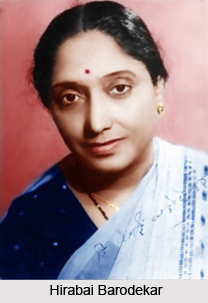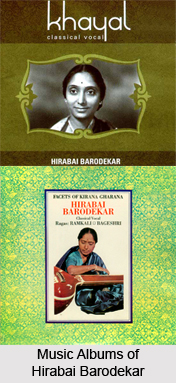 Hirabai Barodekar was a well known Indian Hindustani Classical Music singer and Vocalist, who belonged to the Kirana Gharana. Hirabai Barodekar also performed along with Saraswati Rane, her younger sister, whom Hirabai had also taught the Jugalbandi style.
Hirabai Barodekar was a well known Indian Hindustani Classical Music singer and Vocalist, who belonged to the Kirana Gharana. Hirabai Barodekar also performed along with Saraswati Rane, her younger sister, whom Hirabai had also taught the Jugalbandi style.
Early Life of Hirabai Barodekar
Hirabai Barodekar was born in Miraj in 1905 to Abdul Karim Khan`s second wife, Tarabai Mane, into an exceptionally legendary family of Hindustani singers, who were the trendsetters of the Kirana Gharana. She was the daughter of Ustad Abdul Karim Khan and the niece of Ustad Abdul Waheed Khan. It is very well understood that she took to singing from a very early age. She trained under both the stalwarts, and also under his famed brother Sureshbabu Mane. During her early years, she was more attracted to on-stage performances and had been a fine stage actress. Though of an extremely shy disposition, she was cajoled by the formidable Kesarbai Kerkar to sing for the public. She was a true follower of the Kirana style of rendition, and had contributed substantially to the Marathi musical genre. Hirabai Barodekar had two other siblings, Sureshbabu Mane and Saraswati Rane. All the 3 siblings were greatly responsible for the dissemination of the Kirana style in several parts of the country. She was popularly called Kirana ki Koyaliya, by her admirers.
The young Hirabai, or Champakali as she was called, who had inherited her father`s genes, was keen on becoming a singer, to which her mother was of a different opinion - she wanted her to continue with her studies. Though brought up in Islamic traditions, all the children were brought back to the Hindu fold following their mother`s return to the royal house of her parents in Baroda where they grew up. Later, Hirabai learned under her illustrious paternal uncle, Ustad Abdul Waheed Khan and adopted his elaborate method of Raga development. She also learnt under her brother, the prodigiously gifted, Sureshbabu Mane for a long time. It was he, who groomed her in the features of Kirana Gayaki.
 Career of Hirabai Barodekar
Career of Hirabai Barodekar
Besides being a classical singer, Hirabai was also a fine stage actress. Her elegant features and her fine singing voice were her greatest assets. She was the first woman to appear on the professional Marathi stage. To Hirabai goes the credit for having introduced classical music in the place of light music into Marathi Natya Sangeet. She both sang and also acted in different roles, so much so that she became quite a celebrity in Maharashtra. She quit the stage when cinema started making deep inroads into the cultural scene.
Her soft and flowing voice came to be noted when she had turned 15. The fastidious Kesarbai Kerkar was impressed with her voice and confidently decided to introduce this introverted teenager to the to the formidable Calcutta (now Kolkata) audience, comprising of several musicians and connoisseurs. In the 1950s and 1960s, she was easily one of the most popular woman singers in Maharashtra. Her command over Natya Sangeet and Thumri also widened her audience base. Hirabai did a lot to popularise classical music among the people, especially among women, such that her music became the topic of discussion in several households. She settled down in Pune among the people and the audience who loved her, and who gratefully acknowledged the major role she played in disseminating Kirana gayaki in western India.
Hirabai`s music offers the quintessence of Kirana gayaki. She would elaborate a Raga using the note-by-note Badhat style characteristic of Kirana masters in a serene and stately manner, taking care to invest each note with the right emotional touch or caress. Her recordings of Yaman and Multani illustrate her rich vocalism. Her soulful Multani has been hailed by many as one of the greatest ever recorded. It has become the touchstone by which other singers` renditions are judged to this day. The delicate touches of Karuna Ras she invests the Bandish Kavan Desh Gaye with, makes it an unforgettable experience. Her haunting Bageshri shows her fine sense of melody as it does her ability to weave a mesh of corresponding moods. The composite mood evoked is one of Viraha-Shringar. Hirabai had also brought out an album with her sister Saraswati Rane, in which they gave an excellent duet performance of Chandrakauns.
Today her legacy is carried on by her accomplished disciple Prabha Atre, a well-known scholar-singer in her own right. Unlike the other women singers from Western India who had to face a lot of opposition and problems, Hirabai had a relatively smooth life and career. She was the only woman singer in pre-Independence era, who was able to balance popular appeal and success with an unwavering devotion to the high doctrines of classicism. These traits were to prove inspiring to many women singers that followed.




